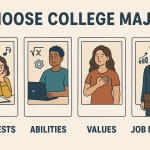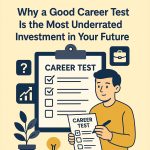Career News
Best Career Test: Choose a Career by Motivation with MAPP

Why Motivation Is the Missing Piece in Every “Career Test” (and How to Measure It Right)
Most people choose careers the way they choose streaming shows by scrolling through what’s popular, asking friends, and sampling a few “episodes.” It works—until the plot drags. The job that looked perfect on paper slowly drains you. Performance slips, growth stalls, and you start to wonder whether the problem is you…or the fit.
The real culprit is usually neither. It’s misaligned motivation.
Skills matter. Experience matters. But decade after decade of outcomes research, the strongest, most durable predictor of sustained success is motivation the internal engine that keeps you curious, focused, and resilient when the work gets hard. The best “career test,” therefore, is not a quick quiz that lists trendy jobs. It’s a structured way to map your motivational pattern to environments where that pattern thrives.
This article explains why motivation is the keystone of career choice, how it differs from interests and personality, how to evaluate your own motivational drivers, and how to use a rigorous assessment the MAPP® (Motivational Appraisal of Personal Potential) to turn insights into a practical plan. MAPP has been used by over 9,000,000 people and thousands of career coaches worldwide because it turns abstract self-knowledge into clear, evidence-based career direction.
1) Why Motivation Outperforms “Skills-Only” Career Planning
Consider two engineers with identical résumés:
- Engineer A loves open-ended problems, rapid iteration, and cross-functional debates.
- Engineer B thrives in stability, detailed specifications, and meticulous quality control.
Put A into a highly regulated medical-device production role and watch frustration rise. Put B into an ambiguous, pivot-prone startup and watch energy evaporate. Each can learn the other’s environment, but motivation—the preference for a certain pattern of problems, pace, and people determines whether they want to keep learning there.
Motivation drives five performance levers that skills alone cannot:
- Attention – We stick with tasks that feel intrinsically rewarding, making fewer errors and gaining mastery faster.
- Effort – Motivation increases discretionary effort, the “above and beyond” that managers recognize and promote.
- Resilience – When setbacks hit, motivated people recover faster because the work still feels meaningful.
- Learning Velocity – We absorb feedback and new tools quicker in domains we want to understand.
- Long-Term Fit – Motivation predicts whether you can do the job year after year without burnout.
If you’ve ever wondered why a smart hire underperforms or why your own productivity varies wildly by project, motivation is the missing variable.
2) Motivation vs. Interests vs. Personality (Know the Difference)
Many career tests collapse three distinct lenses:
- Interests – What topics or activities you find enjoyable (e.g., biology, writing, sales).
- Personality – Stable behavioral tendencies (e.g., introversion, conscientiousness).
- Motivation – What drives you to engage: pace, variety, autonomy, persuasion, structure, analysis, hands-on work, people impact, etc.
You might like biology (interest), be organized (personality), but feel most energized by persuading stakeholders and driving change (motivation). That pattern points more toward healthcare product strategy or medical sales leadership than solitary lab research.
Treating these lenses as interchangeable causes classic mismatches people who love a subject but dislike the day-to-day. Motivation clarifies the work style and reward pattern you need to feel alive on Monday mornings.
3) The Anatomy of Motivation: What You’re Solving, With Whom, and How Fast
To translate motivation into career choices, evaluate three dimensions:
A) Problem Preference
- Ambiguous puzzles vs. clear procedures
- People conflicts vs. technical constraints
- Systems thinking vs. hands-on making
- Immediate fixes vs. long-range strategy
B) Context & Collaboration
- Solo focus vs. continual teamwork
- Persuasion/leadership vs. advisory/support
- Service to individuals vs. service to organizations
- Stakeholder complexity (few vs. many)
C) Pace & Variety
- High-velocity change vs. steady rhythms
- Many small projects vs. one big mission
- Crisis response vs. careful planning
Write yourself a simple motivational positioning statement:
“I’m at my best when I [problem preference] with [context], at a [pace/variety] ideally where success looks like [impact you care about].”
Example: “I’m at my best when I simplify messy, multi-team projects, rally people around a plan, and move fast success looks like visible business impact every quarter.” That sounds like product management, operations leadership, or client-facing consulting not individual research.
4) Common Career Pains That Motivation Solves
- The Topic Trap – You love the subject (e.g., film), hate the workflow (e.g., solitary editing).
- Promotion Paradox – You excel, get promoted to management, then miss hands-on creation.
- The Prestige Prison – Elite role, impressive brand, but your daily tasks don’t match your motivational pattern.
- Burnout Without a Cause – No crisis, no toxic boss, yet chronic fatigue because the work style is wrong for you.
- Chronic Job-Hopping – You keep switching domains, but your day-to-day still clashes with your drivers.
The antidote isn’t just “change companies.” It’s match the job’s motivational signature the pattern of problems, collaboration, and pace to yours.
5) How to Audit a Role for Motivational Fit
When evaluating a team or job description, investigate:
- A day in the life – What proportion of time is spent on analysis vs. persuasion vs. documentation vs. firefighting?
- Decision rights – Who decides what? Are you energized by autonomy or prefer clear escalation?
- Cadence – Weekly deliverables or quarterly milestones? Constant pivots or stable roadmaps?
- Feedback loop – Do you see outcomes quickly (sales, operations) or slowly (policy, research)?
- People load – How many interfaces? Are you energized by stakeholder management or prefer deep solo work?
Score each element 1–5 for “Energizes Me” vs. “Drains Me.” Patterns will leap off the page.
6) Why Traditional “Career Quizzes” Fall Short
Quick quizzes and generic lists often:
- Emphasize interests over motivators, so you get topic-based suggestions without predicting how you’ll feel doing the work.
- Ignore trade-offs (e.g., high variety can reduce depth; high autonomy raises ambiguity).
- Provide outputs you can’t defend in interviews or to yourself six months later.
- Offer advice not linked to actual labor-market data.
You need an assessment that is psychometrically sound, reveals your motivational blueprint, and maps it to real occupations with modern data.
7) Enter MAPP®: The Gold Standard for Measuring Motivation
The MAPP® (Motivational Appraisal of Personal Potential) is a 71-item, forced-choice assessment designed to surface the core motivational drivers and patterns that underlie career satisfaction and sustained performance. Over 9,000,000 people—students, career-changers, military personnel, and executives—plus thousands of professional coaches and guidance offices have used MAPP because it is:
- Motivation-first – It goes beyond interests and personality to pinpoint what propels you.
- Bias-resistant – Forced-choice triads reduce social desirability (“answering how you wish you were”).
- Actionable – Results link to real job families and educational pathways, not just abstract labels.
- Readable – Clear, coach-friendly language you can use immediately with clients or on your own.
- Current – Results integrate occupational frameworks such as O*NET and align with evolving workforce trends.
What You Get in a MAPP Report
- Motivational Profile – Your strongest drivers across domains like change/variety, persuasion, organizational leadership, analysis, hands-on technical work, harmony, detail orientation, and more.
- Work-Style Implications – Concrete guidance on environments where you’ll likely thrive (and struggle).
- Career Fit Mapping – Suggested occupations and fields that match your pattern, with context on market outlooks.
- Development Advice – How to manage blind spots and capitalize on strengths when jobs can’t perfectly match.
- Team & Leadership Signals (advanced) – How you collaborate, the roles you naturally assume, and how to communicate with contrasting styles.
Thousands of coaches prefer MAPP because it compresses months of exploratory conversations into a shared, precise vocabulary. Clients feel seen; plans get specific; momentum builds.
8) Case Snapshots: Motivation in Action
A) The “Stalled Star” Analyst → Product Marketing
- Before: Brilliant with numbers, exhausted by solitary, back-office work.
- MAPP Pattern: High persuasion, high change/variety, moderate analysis, low routine.
- Move: Transitioned to product marketing in a growth-stage SaaS company—storytelling from data, cross-team influence, fast cycles.
- Outcome: Promotion in 12 months; energy restored.
B) The Compassionate Nurse → Health-Systems Quality Lead
- Before: Clinically excellent but drained by night shifts and constant crisis.
- MAPP Pattern: Strong structure, systems thinking, service orientation; lower tolerance for chaos.
- Move: Quality & safety role—root-cause analysis, policy design, staff training.
- Outcome: Greater impact, better hours, satisfaction back.
C) The DIY Founder → Engineering Manager
- Before: A startup generalist doing everything.
- MAPP Pattern: High coaching/organization, moderate technical depth, low desire for ambiguity.
- Move: Joined a mid-size tech firm as an engineering manager—people development and process building.
- Outcome: Stable growth path and clearer wins.
These transitions succeeded not because the people learned entirely new skills, but because they reframed their skills in roles that matched their motivational DNA.
9) How to Use MAPP to Make a Confident Career Move
- Take MAPP – Set aside 20–25 minutes. Answer instinctively.
- Extract Your Top Drivers – Circle the 3–5 highest motivational dimensions.
- Write Your Fit Hypothesis – “I’m energized by [drivers]; I’m drained by [lowest drivers].”
- Map to Roles – Use the career suggestions as starting points. Compare day-to-day realities against your drivers.
- Run Micro-Experiments – Shadow calls, small freelance projects, internal rotations, or MOOCs to test fit quickly.
- Tell a Coherent Story – Convert results into a compelling narrative for résumés and interviews:
- “Here’s the pattern of work I’m best at.”
- “Here’s evidence from my track record.”
- “Here’s why this role’s environment matches, so I’ll ramp quickly and stay engaged.”
10) For Career Coaches: Why MAPP Elevates Your Practice
- Speed to Insight: Compress discovery into a single, reliable profile; start sessions at depth.
- Shared Language: Align clients and stakeholders (parents, schools, hiring managers) with concrete, coach-friendly outputs.
- Better Outcomes: Clients commit to plans that fit; you build testimonials and referrals.
- Scalable Offering: Pair MAPP with goal-setting, interview coaching, and job-search programs; sell cohorts to schools and companies.
- Ethical Clarity: Motivation-based advice avoids gatekeeping; it expands options rather than pigeonholing.
11) Motivation in the Age of AI and Automation
AI excels at routine pattern recognition, high-volume recall, and structured prediction. What remains distinctly human and often motivation-driven are:
- Complex persuasion and trust-building
- Cross-domain creativity and synthesis
- Ethical judgment and stakeholder balancing
- Hands-on dexterity in chaotic environments
- Sense-making in ambiguous systems
MAPP helps you identify where your motivational pattern overlaps with these resilient domains. In a world of rapid change, fit beats fad.
12) A Practical 30-Day Plan
Week 1: Take MAPP. Write your motivational positioning statement. Share it with a mentor or coach.
Week 2: Shortlist 3 target roles/fields that align with your pattern. Informational interview two people in each.
Week 3: Execute one micro-project (e.g., build a portfolio piece, volunteer a process audit, craft a short case study).
Week 4: Update your résumé and LinkedIn to reflect your motivational value proposition. Apply intentionally.
Tip for job seekers: In interviews, explain why you will sustain high energy in the role connect specific job tasks to your motivational profile. Hiring managers listen for this even if they don’t name it.
13) Quick FAQs
Is motivation just “what I enjoy”?
Not exactly. It’s the pattern of work that energizes you and compels sustained effort. Enjoyment is a symptom; motivation is the engine.
Can motivation change?
The core pattern is stable, but how it expresses itself evolves with context, maturity, and new experiences. MAPP gives you a baseline compass you can revisit as you grow.
What if my current job can’t change?
Use your motivational profile to craft job shaping shift 10–20% of your workload toward energizing tasks (projects, committees, client types). Small shifts create surprising gains.
14) Bottom Line
A “career test” that stops at skills or interests can point you in the right direction—but motivation determines whether you’ll arrive and stay. When your daily work aligns with your motivational blueprint, performance and wellbeing compound.
That’s why millions of individuals and thousands of coaches trust the MAPP® assessment: it translates your inner drivers into a concrete, defensible career strategy.
Ready to match who you are with what you do?
Take the MAPP assessment on Assessment.com and turn guesswork into guidance.





